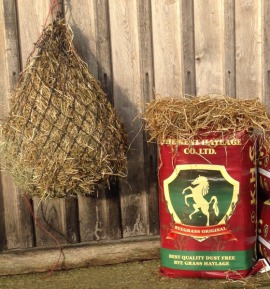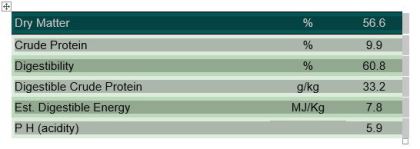

Haylage is Highly Nutritious
Advantages of Haylage V's Hay
• Haylage is dust free – healthier and no need to soak
• Haylage bales are denser – less storage required
• Haylage bales are wrapped in polythene – can be stored outside
• Haylage is more palatable than hay – more enjoyable and less wastage
• Haylage has a higher nutritional value – reducing your "hard feed" requirments
• Haylage is a more natural feed and more easily digested
horses prefer wetter forages (many horses dip their own hay)
• Haylage is more cost-effective
Horses need adequate fibre in their diet to keep their large intestine working properly and, traditionally, in the winter period, this has been supplied by hay. But acquiring hay of consistent quality has always been a problem as the horse is a fussy feeder and will reject poor quality material, especially if there is an unusual smell or significant moulding present.
Poorer quality hay is low in nutrients and could cause severe long-term health problems due to the presence of moulds. The low moisture content of hay (about 10%) allows the mould spores to become
airborne which may cause an allergic respiratory disease called ‘Chronic Obstructive Pulmonary Disease’ (COPD) – commonly known as ‘broken wind’, ‘dust cough’ or ‘dust allergy’. Already up to one in
every five horses suffers from some form of dust allergy.
Once a horse has been affected it will never recover and will always need special attention to minimise exposure to ‘dust.’ For instance it will be necessary to soak hay prior to feeding, a tiresome,
labour-intensive task that leaches out nutrients leading to a further reduction in the hay’s nutritional value and may still not succeed in controlling the disease.
Many equine nutritionists now recommend feeding haylage instead of hay. Haylage is much closer to the horse’s natural diet of grass, both in texture and nutritional value – it is more palatable and
digestible than hay, has a higher nutritional value and is less dusty. If made properly it will contain few, if any, mould spores and its higher moisture content (about 40%) helps prevent any spores
that are present from becoming airborne and causing problems.
Our Haylage at KHC is made from perennial ryegrass, which is cut like hay, but instead of being left to dry completely, it is baled when the grass has wilted and the dry mater content is around 50% (this means that up to 90% of the feed value of fresh grass is retained). The bales are then compressed and sealed into airtight bags. Natural fermentation takes place inside the bags, preserving the grass as haylage.



